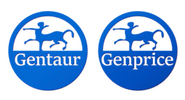Description
FOXP2 Antibody | 27-936 | Gentaur UK, US & Europe Distribution
Host: Rabbit
Reactivity: Human, Rat, Dog
Homology: N/A
Immunogen: Antibody produced in rabbits immunized with a synthetic peptide corresponding a region of human FOXP2.
Research Area: Transcription, Cancer
Tested Application: E, WB
Application: FOXP2 antibody can be used for detection of FOXP2 by ELISA at 1:62500. FOXP2 antibody can be used for detection of FOXP2 by western blot at 0.5 μg/mL, and HRP conjugated secondary antibody should be diluted 1:50, 000 - 100, 000.
Specificiy: N/A
Positive Control 1: Cat. No. 1211 - HepG2 Cell Lysate
Positive Control 2: N/A
Positive Control 3: N/A
Positive Control 4: N/A
Positive Control 5: N/A
Positive Control 6: N/A
Molecular Weight: 80 kDa, 83 kDa
Validation: N/A
Isoform: N/A
Purification: Antibody is purified by peptide affinity chromatography method.
Clonality: Polyclonal
Clone: N/A
Isotype: N/A
Conjugate: Unconjugated
Physical State: Liquid
Buffer: Purified antibody supplied in 1x PBS buffer with 0.09% (w/v) sodium azide and 2% sucrose.
Concentration: batch dependent
Storage Condition: For short periods of storage (days) store at 4˚C. For longer periods of storage, store FOXP2 antibody at -20˚C. As with any antibody avoid repeat freeze-thaw cycles.
Alternate Name: FOXP2, SPCH1, CAGH44, TNRC10
User Note: Optimal dilutions for each application to be determined by the researcher.
BACKGROUND: FOXP2 is an evolutionarily conserved transcription factor expressed in fetal and adult brain. This transcription factor is a member of the forkhead/winged-helix (FOX) family of transcription factors, and contains a FOX DNA-binding domain and a large polyglutamine tract. Members of the FOX family of transcription factors are regulators of embryogenesis. The product of this gene is thought to be required for proper development of speech and language regions of the brain during embryogenesis. Although a point mutation in this gene has been associated with the KE pedigree segregating developmental verbal dyspraxia, no association between mutations in this gene and another speech disorder, autism, has been found. Four alternative transcripts encoding three different isoforms have been identified.










